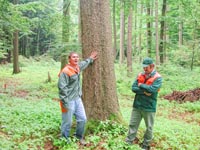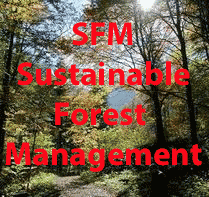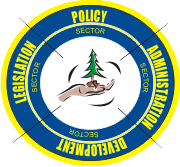Forest Owner Associations
General Information and initial situation
|
|
Weilhart as a contiguous forest area with a total area of about 10.000 ha comprises about 5.000 ha of large scale forests owners (Castell and co-onwers) and about 5.000 ha of small holder private forests. The 5.000 ha of core area make up the core of the Weilhart forest area, whilst the small holder private forest make up the fringe zone congregated around the core.
In geological terms Weilhart forest has developed on frontal moraine walls which go back to the last ice age as well as on gravel terraces which have evolved in the inter ice ages and in post ice age periods. The frontal moraine walls and the gravel terraces are covered by layers of loam of aolic origin and with varying thickness. These loam layers make up the base material for recent soil genetic processes. From a climatic perspective Weilhart forest is located in the fringe area of the sub-atlantic climatic zone. The climate is dominated by mild, humid winters and moderately warm and moist summers. The long term annual average precipitation amount to 900-1000 mm and the long term annual mean temperature amounts to 7,8°C. From an forest ecologic perspective Weilhart forest is located in the alpine foreland, forest association 7, growth district 7.1 western alpine foreland, the altitude zone is colline up to sub-montane.
The natural forest society is an oak-beech mixed forest, whereby an admixture of fir is possible in higher altitudes. Representative tree species in this forest society are:
| Common oak (Quercus robur) |
Common Beech (Fagus sylvatica) |
Hornbeam (Carpinus betulus) |
Ash (Fraxinus) |
| Alder (Alnus glutinosa) |
Wych Elm (Ulmus glabra) |
Common Elm (Ulmus minor) |
Sycamore Maple (Acer pseudoplatanus) |
| Field Maple (Acer campestre) |
Fir (Abies) |
on extreme locations Scots Pine (Pinus sylvestris) |
Littleleaf Linden (Tilia cordata) |
Most important stand forming tree species from an economic point of view are:
- Common Oak (Quercus robur)
- Ash (Fraxinus excelsior)
- Common Beech (Fagus sylvatica)
- Sycamore Maple (Acer pseudoplatanus)
- Littleleaf Linden (Tilia cordata)
- Fir (Abies alba)
- Scots Pine (Pinus sylvestris) and
- Spruce (Picea abies)
whereby all of the above tree species can also occur as stand accompanying tree species.
Spruce (picea) as the most interesting tree species from an economic perspective can – dependant on the altitude occupy considerable proportions of the forest area – but will never become the dominant tree species. Centuries of human interference have destabilized the economic balance in Weilhart forest.
The most serious effects caused by economically driven forest management of Weilhart forest were (in order of decreasing significance):
- Tree species selection (spruce Picea), i.e. silviculture,
- Removal of forest litter/mulch,
- Too high game density and
- In the recent years immission loading
The presently occurring forest stands are vulnerable to pests of all kind; biotic (insects, fungi, …) and abiotic (storms, snow,…) pressures and do occur on soils showing extreme symptoms of deterioration (pH values of 2,5 and below were measured. Since biotic damages caused by the spruce sawfly (Pristiphora abietina) have increased dramatically and since the stability of the stands has declined, action had to be taken.
Targets
- Development of a forest management and planning tool (forest inventory and mapping of stands) since the existence of such a tool is a precondition for all management activities
- Elaboration of a project to make the forest accessible for truck; since only the existence of a forest road network suitable for trucks allows to carry out a variety of silvicultural measures at reasonable costs and allows harvesting of final products with an economically attractive and required profit margin
- Improvement of silviculutural siutation in all stand classes by promotion of recruitment and thinnings
- Improvement of soil quality by
- close to nature reforestation (taking into consideration ecologic and economic perspectives) and taking advantage of the potential for natural regeneration of autochthon broad leave tree species and
- Application of harvest methodologies with low impacts on soils using the potentially available machines and human resources of close by agricultural holdings (under certain circumstances forwarding by horse power)
- Tending in areas with particularly bad symptoms of degradation
- Reduction of damages caused by spruce sawfly (see position paper)
- Communal marketing of timber by market conform supply behaviour (sales of timber only in periods with high timber prices and foregoig final harvest in periods of low timber prices)
- Becoming active stakeholder in game management (only as an association speaking with one voice the forest owners could gain enough leverage)
- Seminars, courses, trainings and workshops for the members in the fields of forest ecology and forest economy
- Public relations activities in the form of information events for the general public and the riparian population to inform the on the environmental services and environmental externalities provided by forests and the Forest Associations actions and efforts
- Exchange of information/experiences and strengthened cooperation/collaboration between the members (e.g. covering of one member’s timber supply by another member)









